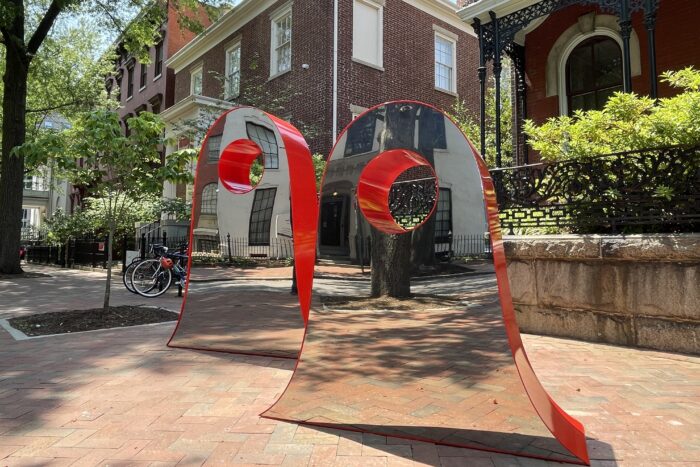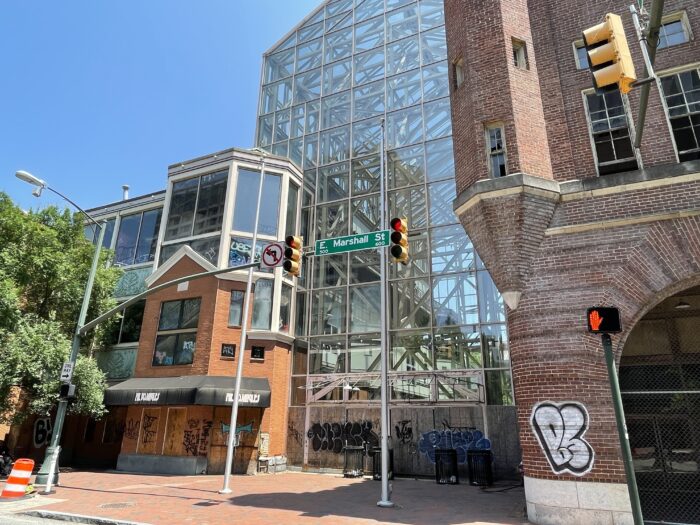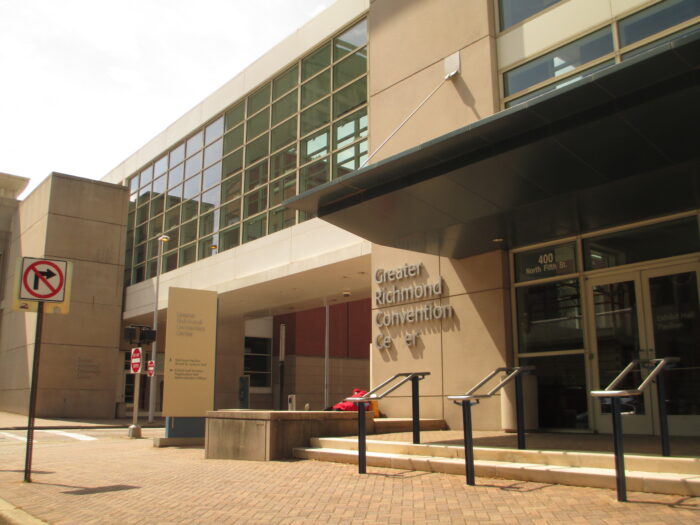
Mickael Broth’s “The Hole Truth” offers a reflection along Clay Street in front of The Valentine. (BizSense photos)
On June 6, a late afternoon tempest drenched downtown, but skies cleared as if on cue as twin doors of the Valentine history center were swung open onto East Clay Street. About 60 folks left the bar and canape station to descend steep granite steps to the brick city sidewalk. There they confronted the city’s newest public art installation, “The Hole Truth,” a human-scale abstract sculpture by Mickael Broth. Its sleek mirrored and cherry red metal surfaces were as bright as the smiles on the faces of the Virginia artist, his family, admirers and Valentine patrons who gathered around the piece. After brief dedicatory remarks, including shout outs to the Common Wealth Public Art Fund of the Community Foundation, and the city’s public art commission and public works department, the snapping of selfies and group shots ensued.
“It doesn’t hit you over the head,” Bill Martin, the Valentine director, told those assembled. “It is engaging if you sit, look at it, think, and then go into the museum. Finding truth is a challenge and museums help us do that.”
“Hole” is proof that shiny things that enhance our cityscapes needn’t be tall buildings or require acres of real estate like the proposed-but-nixed $325 million VCU Health office tower (for which the university is contesting a $73 million bill), or a new minor league ballpark-anchored development.
As attendees schmoozed, Martin drew a fellow staff member across Tenth Street where demolition of the ruinous, city-owned public health and safety building is nearly done. He pointed excitedly at a new urban vista that’s been created with the removal of the blockade-like eyesore. “Look, you can see the convention center from here.” He extolled how future conventioneers will be able to stroll directly down East Clay Street via a new street connector between Ninth and Tenth streets, to the Valentine’s Court End neighborhood. Once there, they could explore its considerable historical and architectural treasures. In addition to the museum, these include the John Marshall House, White House of the Confederacy, Monumental Church and VCU’s Egyptian Building – all National Historic Landmarks. The university campus also boasts such architecturally distinctive landmarks as Hunton Hall (a student activities building that was formerly First Baptist Church) and the commanding West Hospital, a red brick Art Deco beacon on the downtown skyline. Once East Clay Street is reconnected (although capital funding has apparently not been budgeted), Martin said the Valentine is positioned to serve as a visitor center. “The Hole Truth” will greet those arriving along Clay from the convention center.
But, ah, the Greater Richmond Convention Center.
A Richmond Times-Dispatch front page headline on May 26 wasn’t encouraging: “Convention center often lies empty,” it read. “Leaders say the fix is adding a big hotel.” Hmm. Another big shiny object to prop up another once shiny new object. And by the way, back in the day, wasn’t development of the drab convention center, whose construction chewed up numerous blocks of historic Jackson Ward residential fabric, rationalized partly as a panacea for augmenting the Richmond Coliseum?
The Times-Dispatch article also reported that the convention center stood empty for 19 days this past March; a new 500-room hotel is needed. If downtown’s hotels – the Berkeley, Commonwealth Suites, Delta, Graduate, Hampton Inn, Hilton, Holiday Inn Express, Jefferson, Linden Row, Marriott, Marriott Courtyard, Omni and Quirk – don’t collectively have enough rooms, maybe the center’s sales staff needs to pump up its efforts.
But there’s something more critical. The immediate environs of the convention center need major attention and sprucing up. When prospective convention advance teams and planners visit downtown, one can only imagine the tortured pathways local officials must guide them to avoid the decay and visual pollution of the immediate surroundings.
Currently, upon exiting the convention center, there’s no attractive path to Court End. After crossing North Fifth Street from the main entrance, East Marshall Street is a glorified service road lined with parking decks. A bright spot is the historic Blues Armory, which could provide a picturesque passageway. However, it’s in deplorable shape with a chain-link fence blocking access to the arcade – the implied message is don’t relieve yourself or camp out here. Graffiti scrawled on the adjacent former Sixth Street Marketplace food court is literal. Charming.
Another route to Court End is passing the Coliseum via Nina Abady Park (the park’s name should be removed to better honor the legacy of this storied civic leader). And the Coliseum, a once-vaunted venue for conventions, sports and entertainment has long been shuttered. Why? Norfolk, Hampton, Salem/Roanoke are still getting excellent mileage from their midcentury modern arenas. Why have we forsaken our downtown destination?
OK. Suppose conventiongoers head west to Jackson Ward and Second Street. “The Harlem of the South,” we’re told. But despite some destination restaurants and renovation successes around the Hippodrome, it is a rag-tag affair. The corridor needs a thorough makeover like Shockoe Slip received a generation ago.

The Blues Armory (right) and former Sixth Street Marketplace buildings sit idle and graffiti-covered.
Finally, can we rely on East Broad Street, downtown’s main thoroughfare to charm, well, not offend visitors? Hardly. The busy crossroads of Broad and Fifth is populated with more vehicles than the combined service stations at Zion’s Crossroads (without the gasoline). The Marriott and Hilton hotels are set, suburban-like, behind surface parking lots. Public lots also fill entire half blocks between Fourth and Fifth and Sixth and Seventh. The new General Assembly parking deck at Ninth and Eighth is a slap-in-the face to the city.
But surely the median strip down the center of Broad can mitigate the situation. Landscaping and trees are forgiving. But the planter boxes stingily plopped atop mostly mulch are underwhelming and pathetic.
So, what to do? Let’s get cracking on the Clay Street connector between the convention center and Court End with its architectural and historic treasures from neoclassical to Art Deco. If not, can we provide visitors a pair of blinders in their welcome packets? They’ll understand. Americans got used to face masks during the pandemic.

Mickael Broth’s “The Hole Truth” offers a reflection along Clay Street in front of The Valentine. (BizSense photos)
On June 6, a late afternoon tempest drenched downtown, but skies cleared as if on cue as twin doors of the Valentine history center were swung open onto East Clay Street. About 60 folks left the bar and canape station to descend steep granite steps to the brick city sidewalk. There they confronted the city’s newest public art installation, “The Hole Truth,” a human-scale abstract sculpture by Mickael Broth. Its sleek mirrored and cherry red metal surfaces were as bright as the smiles on the faces of the Virginia artist, his family, admirers and Valentine patrons who gathered around the piece. After brief dedicatory remarks, including shout outs to the Common Wealth Public Art Fund of the Community Foundation, and the city’s public art commission and public works department, the snapping of selfies and group shots ensued.
“It doesn’t hit you over the head,” Bill Martin, the Valentine director, told those assembled. “It is engaging if you sit, look at it, think, and then go into the museum. Finding truth is a challenge and museums help us do that.”
“Hole” is proof that shiny things that enhance our cityscapes needn’t be tall buildings or require acres of real estate like the proposed-but-nixed $325 million VCU Health office tower (for which the university is contesting a $73 million bill), or a new minor league ballpark-anchored development.
As attendees schmoozed, Martin drew a fellow staff member across Tenth Street where demolition of the ruinous, city-owned public health and safety building is nearly done. He pointed excitedly at a new urban vista that’s been created with the removal of the blockade-like eyesore. “Look, you can see the convention center from here.” He extolled how future conventioneers will be able to stroll directly down East Clay Street via a new street connector between Ninth and Tenth streets, to the Valentine’s Court End neighborhood. Once there, they could explore its considerable historical and architectural treasures. In addition to the museum, these include the John Marshall House, White House of the Confederacy, Monumental Church and VCU’s Egyptian Building – all National Historic Landmarks. The university campus also boasts such architecturally distinctive landmarks as Hunton Hall (a student activities building that was formerly First Baptist Church) and the commanding West Hospital, a red brick Art Deco beacon on the downtown skyline. Once East Clay Street is reconnected (although capital funding has apparently not been budgeted), Martin said the Valentine is positioned to serve as a visitor center. “The Hole Truth” will greet those arriving along Clay from the convention center.
But, ah, the Greater Richmond Convention Center.
A Richmond Times-Dispatch front page headline on May 26 wasn’t encouraging: “Convention center often lies empty,” it read. “Leaders say the fix is adding a big hotel.” Hmm. Another big shiny object to prop up another once shiny new object. And by the way, back in the day, wasn’t development of the drab convention center, whose construction chewed up numerous blocks of historic Jackson Ward residential fabric, rationalized partly as a panacea for augmenting the Richmond Coliseum?
The Times-Dispatch article also reported that the convention center stood empty for 19 days this past March; a new 500-room hotel is needed. If downtown’s hotels – the Berkeley, Commonwealth Suites, Delta, Graduate, Hampton Inn, Hilton, Holiday Inn Express, Jefferson, Linden Row, Marriott, Marriott Courtyard, Omni and Quirk – don’t collectively have enough rooms, maybe the center’s sales staff needs to pump up its efforts.
But there’s something more critical. The immediate environs of the convention center need major attention and sprucing up. When prospective convention advance teams and planners visit downtown, one can only imagine the tortured pathways local officials must guide them to avoid the decay and visual pollution of the immediate surroundings.
Currently, upon exiting the convention center, there’s no attractive path to Court End. After crossing North Fifth Street from the main entrance, East Marshall Street is a glorified service road lined with parking decks. A bright spot is the historic Blues Armory, which could provide a picturesque passageway. However, it’s in deplorable shape with a chain-link fence blocking access to the arcade – the implied message is don’t relieve yourself or camp out here. Graffiti scrawled on the adjacent former Sixth Street Marketplace food court is literal. Charming.
Another route to Court End is passing the Coliseum via Nina Abady Park (the park’s name should be removed to better honor the legacy of this storied civic leader). And the Coliseum, a once-vaunted venue for conventions, sports and entertainment has long been shuttered. Why? Norfolk, Hampton, Salem/Roanoke are still getting excellent mileage from their midcentury modern arenas. Why have we forsaken our downtown destination?
OK. Suppose conventiongoers head west to Jackson Ward and Second Street. “The Harlem of the South,” we’re told. But despite some destination restaurants and renovation successes around the Hippodrome, it is a rag-tag affair. The corridor needs a thorough makeover like Shockoe Slip received a generation ago.

The Blues Armory (right) and former Sixth Street Marketplace buildings sit idle and graffiti-covered.
Finally, can we rely on East Broad Street, downtown’s main thoroughfare to charm, well, not offend visitors? Hardly. The busy crossroads of Broad and Fifth is populated with more vehicles than the combined service stations at Zion’s Crossroads (without the gasoline). The Marriott and Hilton hotels are set, suburban-like, behind surface parking lots. Public lots also fill entire half blocks between Fourth and Fifth and Sixth and Seventh. The new General Assembly parking deck at Ninth and Eighth is a slap-in-the face to the city.
But surely the median strip down the center of Broad can mitigate the situation. Landscaping and trees are forgiving. But the planter boxes stingily plopped atop mostly mulch are underwhelming and pathetic.
So, what to do? Let’s get cracking on the Clay Street connector between the convention center and Court End with its architectural and historic treasures from neoclassical to Art Deco. If not, can we provide visitors a pair of blinders in their welcome packets? They’ll understand. Americans got used to face masks during the pandemic.




It would be nice to have the store fronts on Grace between 6th and 5th have something to offer visitors to downtown besides an ugly closed up shop. It’s been many years since they offered signs of life. Richmond can go after legitimate rehabbers for taking too long to complete a job yet those building can sit vacant? Can’t we think up some kind of incentive?
Unfortunately everything said in this article is true. Why anyone would book our convention center is a mystery to me. When one exits the building there is not even a coffee shop in sight or other amenities to attract a visitor. There is no visual attraction from any exit that invites one to walk this way.
Question if VCU is pulling the plug on the payments is that City actually moving to re-alaign and reopen Clay Street still?? Will it have the funding?? And okay 9th to 10th will be open but what about 7th to 9th?? Street coming or fenced off completely for demo and a new convention hotel. That City Center project that will die before Stoney leaves is big part of the “view” being discussed and cheered.
Excellent discussion… I live at East Clay and 3rd, in the shadow of the gruesomely generic (and always empty) Convention Center, and am consistently perplexed why “my” end of Broad Street remains a series of boarded buildings, with no signs of progress. The owners of these structures should be fined for allowing them to sit empty, further decaying, instead of adding condos and new businesses the way Broad is coming back to life a mere 3-4 blocks down. There is so much the city could do to brighten the corridor described here, but alas, our City Council decided to strip… Read more »
Richmond is a fickle city. The future at one time was shockoe bottom and Main Street Station, the death, resurrection and death of the 17th Street farmers’ market. Sixth Street – long dead. Who would have thought any homes north of Broad in Church Hill would be worth 500K and safe? The big surprise – Scotts Addition – any long/short/medium city planning there – nope – just capitalism coming in and for better or worse an area that is almost unrecognizable to anyone who worked there 40 or 50 years ago. The only constant in Richmond is – announce a… Read more »
The question we should be asking is why the Richmond Bio Tech Park never took root. Had that happened, amenities like shops, hotels, and apartments would have grown organically.
Thanks for the love Ed! And for clearly stating the issues hindering an inviting feel to this area of the city. I just drove cross country and it’s beyond frustrating seeing all sorts of places (big cities/small towns) get it right with only minor changes, when I fully believe Richmond has all the right ingredients. We need real commitment to do things with passion. The comment about the planter boxes is 100% spot on. Those were a sad joke when they were first installed. It’s better to do nothing than to do anything halfway. I do have hope.. we had… Read more »